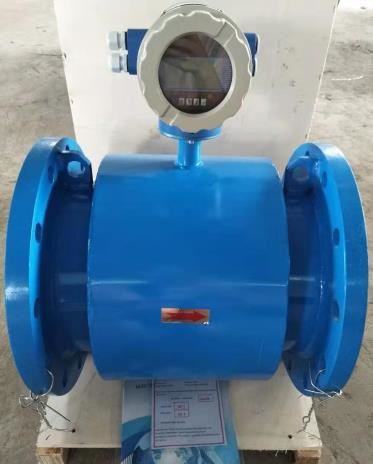Magmeter Flow Sensor

Magmeter Flow Sensor
2. Type: remote type, integrated type, plug-in type
3. Lining material: neoprene, PTFE, PFA, FEP, F46
4. Electrode material: SS316L, HC, HB, Ti, Tan, Pt
1.Application scope and characteristics:
Split and one-piece. The nominal diameter of the pipe is DN6~DN3000.
Magmeter flow sensor has been widely used in industrial technology and management departments such as chemical industry, environmental protection, metallurgy, medicine, papermaking, water supply and drainage.
In addition to measuring the flow rate of general conductive liquids, this instrument can also measure the volume flow rate of liquid-solid mixed media, high-viscosity media, and salt, strong acid, and strong alkali liquids.
⑴. There are no moving parts or flow-blocking parts inside the flowmeter pipeline, which will not cause pressure loss, wear, blockage and other problems.
⑵. This equipment is a volume flow measuring instrument and is not affected by the temperature, viscosity, density and conductivity (within a certain range) of the medium being measured during the measurement process.
⑶. Wide range, up to 1:100. In addition, it is proportional to the average flow velocity of the measured medium and has nothing to do with the axisymmetric flow state (laminar or turbulent).
⑷. No mechanical inertia, sensitive response, can measure instantaneous pulsating flow, and has good linearity, so the measurement signal can be directly converted into a standard signal output by the converter.
2. Preliminary selection:
⑴. First understand the name and properties of the liquid being measured to determine whether the medium is conductive. If the conductivity is less than 5 μs/cm, magmeter flow sensor is the first choice.
Note: This meter can only measure the flow of conductive liquids. If it is gas, oil and most organic liquids that are not general conductive liquids, this meter cannot be used.
⑵. Select the most suitable electrode material and lining material according to the medium characteristics, such as medium temperature, corrosiveness, and whether it contains impurities (wear-resistant linings and electrodes can be selected). Commonly used lining materials include rubber lining and PTFE lining.
Note: The temperature resistance of rubber does not exceed 80℃;
The temperature resistance of PTFE does not exceed 130℃.
Urban sewage generally uses rubber lining and stainless steel electrodes
⑶. Select the meter body flange specifications according to the pressure of the pipeline medium.
Note: The electromagnetic flange specifications are usually from DN10-250 in diameter and the flange rated pressure is ≤1.6Mpa;
When the pipe diameter is DN250-1000, the flange rated pressure is ≤1.0Mpa;
When the actual pressure of the medium is higher than the above pipe diameter-pressure corresponding range, special ordering is required.
⑷. Determine the conductivity of the medium
Note: The conductivity of the measured medium should not be less than 5uS/cm
The conductivity of tap water is about tens to hundreds of uS/cm. Generally, boiler soft water (deionized water) is conductive, while pure water (highly distilled water) is not.
Gases, oils and most organic liquids have conductivities well below 5uS/cm and do not conduct electricity.
⑸. According to site conditions or special user requirements: you can choose integrated type or remote display type (the maximum distance between the remote display converter and the sensor is 100 meters)
What communication functions are needed: The electromagnetic flow converter itself has upper and lower flow limit alarms, frequency and 4-20MA current output, RS485 communication, pulse output, Hart (optional).
⑹. Protection levels are divided into: IP65, IP67, IP68.
Based on the above information, the configuration specifications and model of the flow meter can be determined.

3.Electrode Material Selection Table:

4.Lining Material Selection Chart:

5.FAQ:
1. Q: How to install the water flow meter model?
A: We can provide manuals for the types of water flow meters, please feel free to contact us.
2. Q: How to choose the flow path?
Answer: Yes. Based on your pipeline ID and flow range. We have professional guidance to choose the right flowmeter for you.
3. Q: Can I take samples?
A: Yes, we have materials in stock to help you get samples as soon as possible.
4. Q: Can you provide the shortest delivery time?
A: We have materials in stock, we will provide the fastest delivery time.
5. Q: Can I visit your factory?
A: Of course, if you need, we will help you to visit our factory.
6.Q: How do we pay?
A: We support T/T, Western Union payment, online payment by credit card, LC payment, (payment terms can be negotiated with sales representatives)